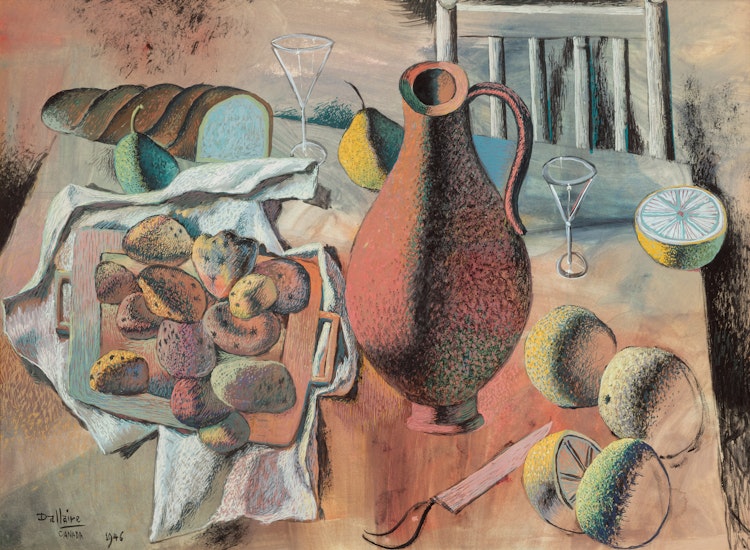Still Life with Bread and Fruit, 1946 by Jean-Philippe Dallaire

Jean-Philippe Dallaire
Still Life with Bread and Fruit, 1946
gouache on paper laid down on card
signed, dated 1946 and inscribed "Canada" lower left
24 x 32 in ( 61 x 81.3 cm ) ( sight )
Auction Estimate: $12,000.00 - $15,000.00
Price Realized $20,400.00
Sale date: May 28th 2025
Private Collection, Montreal
Share this item with your friends
Jean-Philippe Dallaire
(1916 - 1965)
Jean-Philippe Dallaire, the painter, illustrator and professor was born at Hull, Quebec on June 9, 1916. He was raised in a working-class family of 15, and started drawing at age 11. He studied art at the technical school in Hull in 1934; at the Toronto Central Technical School under Charles Goldhammer, Peter Haworth, and sculpture with Elizabeth Wyn Wood in 1935. He studied the Old Masters at Boston in 1936.
From 1936 to 1938 he painted religious murals for the Dominican Fathers near Ottawa and at Fall River, Massachusetts and about this time did large figure studies on the walls of Madam Burger’s restaurant destroyed by the fire which levelled her first famous earring house. In October 1938, with the support of a Quebec government grant, Dallaire went to Paris and studied under Maurice Denis, Georges Desvallières and at André L’Hote’s school. He became familiar with the work of Picasso and the surrealists and met Alfred Pellan.
During World War Two, while under the German occupation in France he was a prisoner at St-Denis, outside Paris. He continued to paint in his confinement, but his wife was released after six months. While interned he come to know Frank Pickersgill who escaped but later died in another camp. On his return to Canada in 1946, he taught painting at the Ecole des Beaux-Arts in Quebec City. He later worked for the National Film Board in Ottawa illustrating animated films. He also filled commissions of designing tapestries.
Writing on the artist, Donald W. Buchanan brought out that Dallaire’s art had been affected by years of internment, by cubist analysis of form, the decorative possibilities and limitations of tapestry design in which he had specialized, and his sensitivities to the myths of French Canada against the realities of Canada today. Buchanan further wrote, “. . . he is obtaining a firm monumentality of design in his canvases. The question is, will he continue to achieve this without losing that gay freedom of detail which has always been such an attraction in his smaller works . . .” At the beginning of the same article Buchanan had spoken of Dallaire’s fantasies often verging on comedy in which melancholy lurked.
He then lived and painted in Montreal from 1957 to 1959. In '59 he moved to Europe permanently. He died of heart failure in 1965, thus ending prematurely a brilliant career. He is represented in the permanent collections of the National Gallery of Canada, the Art Gallery of Ontario and the Museum of the Province of Quebec. Dallaire's works show varied stylistic influences and are always recognized by their draftsmanship and spontaneity in subject and use of colour.
Source: "A Dictionary of Canadian Artists, Volume I: A-F", compiled by Colin S. MacDonald, Canadian Paperbacks Publishing Ltd, Ottawa, 1977

